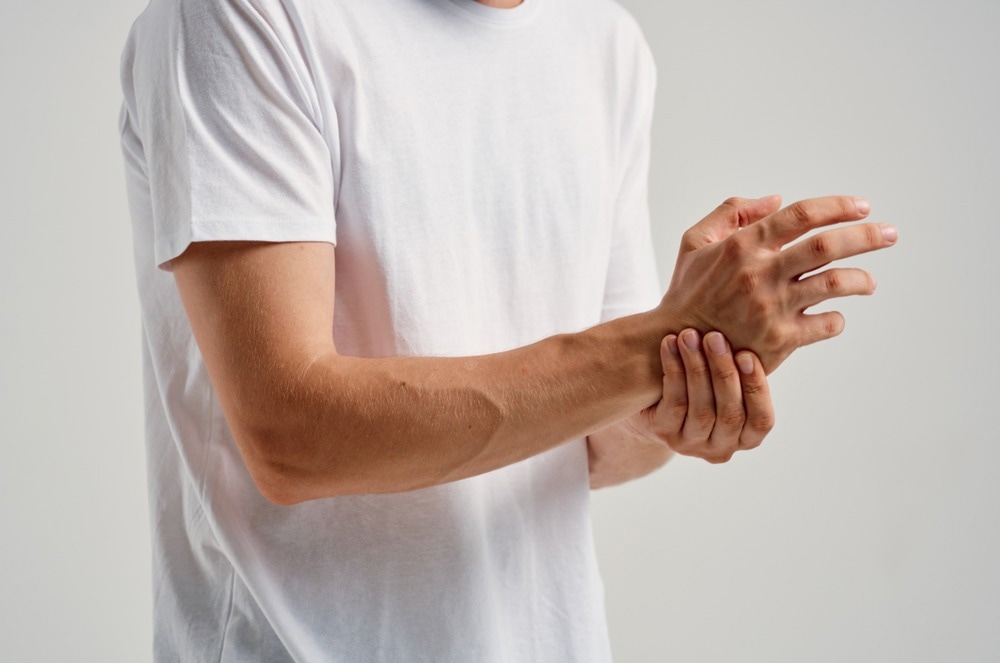 By Neha MathurReviewed by Danielle Ellis, B.Sc.Oct 6 2022
By Neha MathurReviewed by Danielle Ellis, B.Sc.Oct 6 2022In a recent study posted to the bioRxiv* server, researchers demonstrated the feasibility of reproducing the previously observed spatial summation of pain (SSp) effect during the coronavirus disease 2019 (COVID-19) pandemic. Additionally, they measured the association between pain-related expectancy and SSp.
 Study: Reproducibility of spatial summation of pain effect during COVID-19 pandemic. Image Credit: ShotPrime Studio/Shutterstock
Study: Reproducibility of spatial summation of pain effect during COVID-19 pandemic. Image Credit: ShotPrime Studio/Shutterstock

 *Important notice: bioRxiv publishes preliminary scientific reports that are not peer-reviewed and, therefore, should not be regarded as conclusive, guide clinical practice/health-related behavior, or treated as established information.
*Important notice: bioRxiv publishes preliminary scientific reports that are not peer-reviewed and, therefore, should not be regarded as conclusive, guide clinical practice/health-related behavior, or treated as established information.
Background
As per the Sherringtonian context of SSp, nociceptive neurons receiving multiple collateral stimuli from nearby neurons generate action potentials even with stimuli of sub-threshold values. The cold pressor task (CPT) is widely used in studies on nociception and SSp.
About the study
In the present study, researchers asked 68 healthy participants aged 19 to 65 to perform CPT, wherein they had to immerse their non-dominant hands in cold water to induce SSp. They mandated that all the participants perform CPT under two experimental conditions, i.e., gradually immerse and withdraw their hands in water in ascending and descending motion. Notably, the team did not use any laboratory procedures; instead, they worked in a home-based setup. However, they used commercial equipment to conduct this study.
The order of the two experimental conditions was pseudorandom, and the time interval between the two was one hour. During this interval, participants filled out the subjective experience of workload (SEWL) score questionnaire that measured their physical activity. First, the researchers tested the cold pain threshold (PTCOLD) on the examined limb. They placed an ice cube on the palmar surface of the participant's hands and recorded the time (in seconds) till they first experienced pain. The participants remained unaware of the study goal till the end. Then, they were asked to provide their demographic information and guess the study's purpose.
The researchers used a Visual Analogue Scale (VAS) to measure pain intensity after 10, 30, and 50 seconds. Further, they used VAS to measure each participant' expectation of pain intensity vs. the actual perception of pain. Each immersion trial and inter-trial interval lasted 60 seconds and five minutes, respectively. The scale for expectations had anchors of zero to 100, indicating no and the worst pain imaginable. While participants provided ratings, examiners recorded the temperature of the water.
The team used a General Estimated Equations (GEE) model with three factors - condition (ascending, descending), segment (1 to 5), and time (10, 30, 50s) to investigate the effect of stimulation area on pain intensity. Finally, the researchers used Pearson or Spearman rank coefficients depending on data distribution to draw a correlation between SSp and SEWL and pain intensity and pain expectancy.
Study findings
The authors observed a significant SSp effect in home settings. More importantly, they found that stimulating a larger area, on average, resulted in higher pain. Moreover, they observed an interaction between the sequence of immersions and the size of the stimulated area. These interactions indicated that when the stimulated hand segments were of similar size, the pain was perceived differently in the ascending vs. descending condition, i.e., immersion from fingertip to the axilla and from axilla to fingertips.
The reproducibility of this interaction was more prominent in comparing only the immersion of the first-hand segment. However, this interaction likely manifested following a robust activation of the descending pain inhibitory system in the descending condition. Furthermore, the increase in pain in either sequence was disproportional. As observed in previous studies, a five times larger area does not multiply the reported pain intensity by the same value. Thus, it is possible that the duration of the stimulus strongly affected the pain summation pattern.
Considering the last 50s measurements, SSp was partially mediated by the sensitization within the neuroaxis fetching a steeper curve representing the summation trajectory. Another feature of SSp effect was the pattern of pain increase, which a linear and a non-linear equation could explain to the same extent.
Conclusions
The present study introduced a novel methodology to study SSp effect in a home setup using a previously reported ascending/descending paradigm and cold stimulation. This method remarkably reproduced the SSp effect outside clinical and non-laboratory environments, previously shown by Marchand & Arsenault, yet using a modified methodology.
The study method used only the hand and divided it into five segments. Secondly, it used cold stimulation. Thirdly, the study used only home-based equipment. Despite differences and random noise caused by different assessors and temperatures across different households, SSp was stable.
The study also provided mechanistic insights into the SSp effect by showing that its spatial summation could be inferred from a subject's pain expectations. Furthermore, they showed that it was strongly influenced by sensitization and shaped by descending pain inhibition. Although pain expectation might have strongly influenced spatial summation, future studies manipulating pain expectancy must confirm this hypothesis. Also, the increase in stimulus area was exponential in the current study, which could have resulted in less efficient inhibition; thus, the observed more linear increase in pain.

 *Important notice: bioRxiv publishes preliminary scientific reports that are not peer-reviewed and, therefore, should not be regarded as conclusive, guide clinical practice/health-related behavior, or treated as established information.
*Important notice: bioRxiv publishes preliminary scientific reports that are not peer-reviewed and, therefore, should not be regarded as conclusive, guide clinical practice/health-related behavior, or treated as established information.